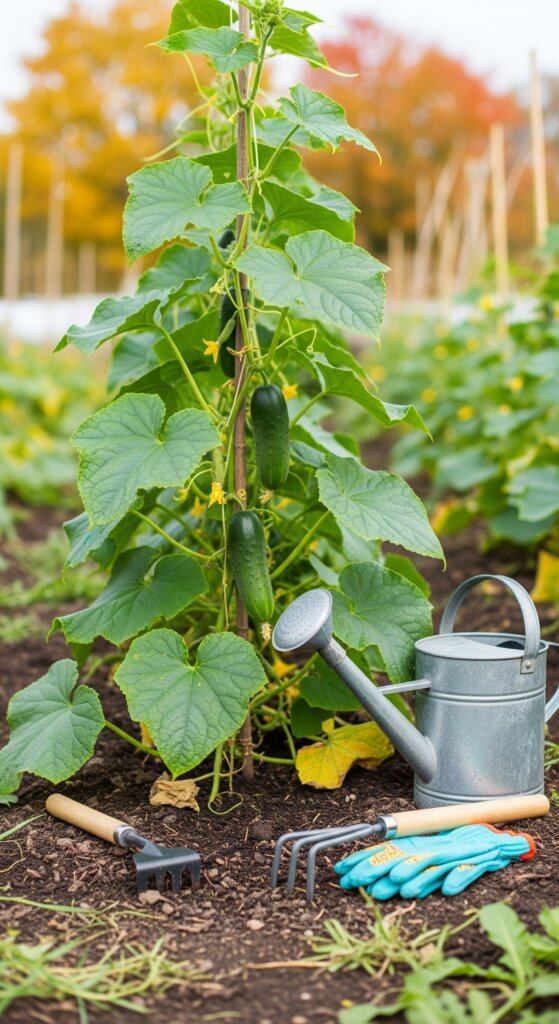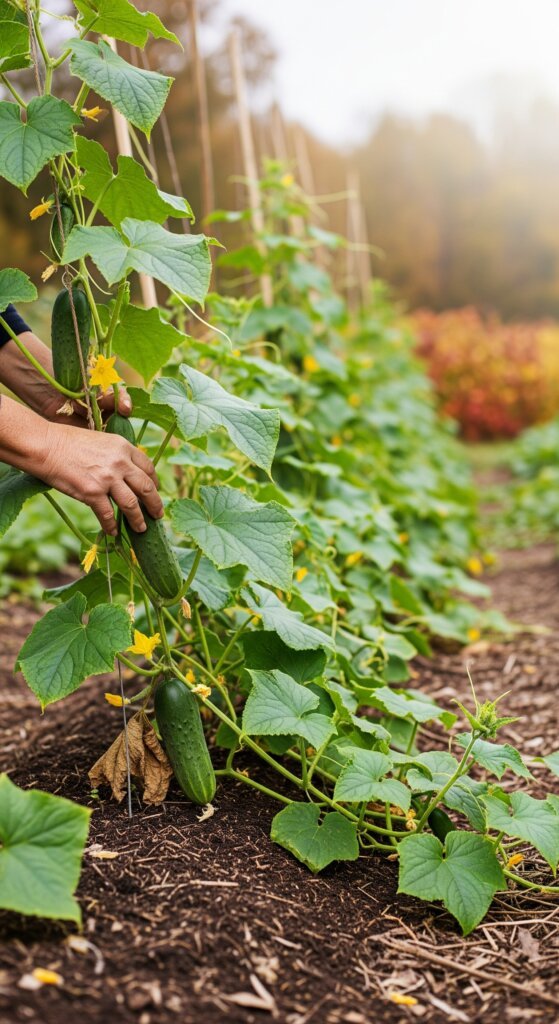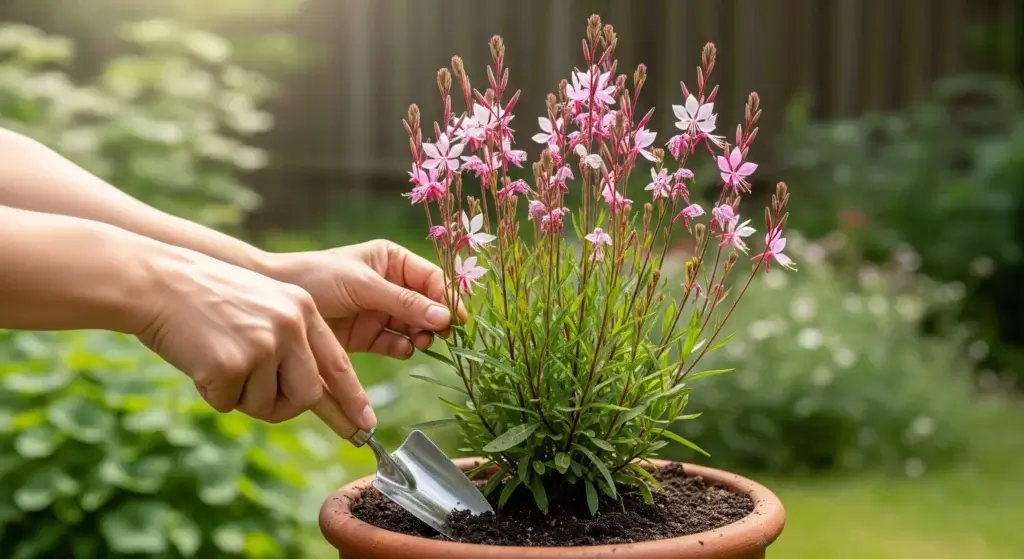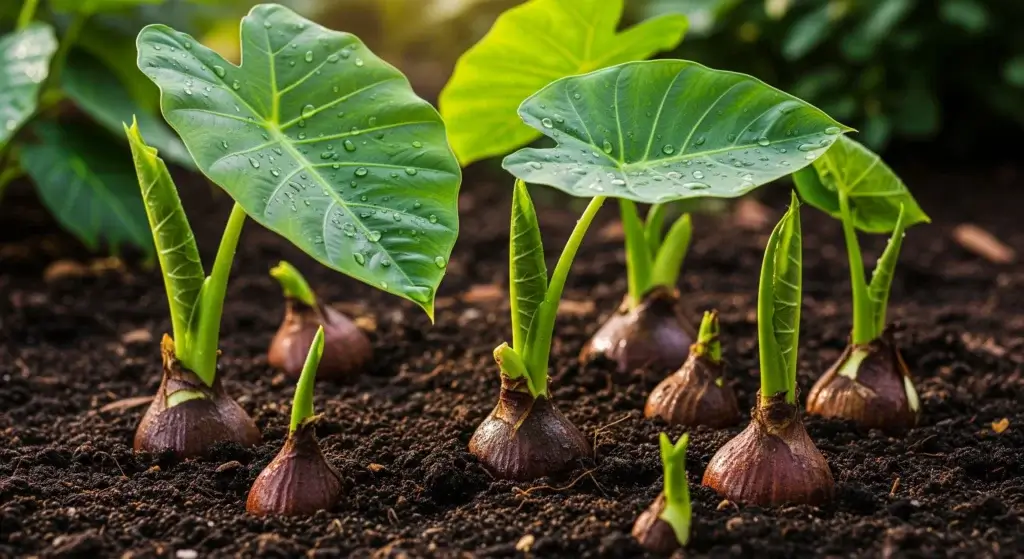
Most folks pack up the garden by late summer, but fall is secretly a great time to grow cucumbers—especially if you’re into less bugs, steady rain, and solid harvests.
Think of it like the bonus level after summer gardening—cooler temps, fewer pests, and still plenty of crunch.
This quick guide covers the basics: the best cucumber types for fall, how to keep them happy as the weather shifts, and when to pick them so you don’t end up with garden pickles on the vine.
Whether you’re a seasoned grower or just planting your first seed, fall cucumbers are a smart move.
Understanding the Benefits of Fall Cucumber Growing
Growing cucumbers in the fall has some real perks that most gardeners miss.
Cooler weather isn’t just more chill for you—it’s better for the plants too. Here’s why fall cukes are kind of underrated:
1. Fewer bugs, less drama
By fall, the usual troublemakers—cucumber beetles, squash bugs, aphids—start tapping out.
You won’t have to babysit your plants like you do in summer.
Less pest pressure means more energy goes into actual growing, not survival.
2. Less disease, more crunch
Powdery mildew and other cucumber-killing fungi hate dry, cool weather.
Fall helps you avoid all that mess, so your plants stay healthier without all the spraying.
3. Better flavor—no joke
Cooler temps slow things down just enough to boost flavor.
Fall cucumbers tend to be crisper, sweeter, and way less bitter.
Just don’t sleep on the frost—pick everything before it hits or you’ll regret it.
4. Bonus round for your garden
With a little planning, you can keep the cucumber party going into October—sometimes November if your weather stays mild.
It’s like getting extra innings in your growing season.

Choosing the Right Varieties for Fall Success
Not every cucumber is built for sweater weather.
If you want fall cukes that actually show up before the frost hits, you’ve gotta pick the right types—fast growers that don’t mind shorter days and cooler nights.
Go for bush or compact types
These guys mature quicker than the long, trailing vines you see in summer.
That’s key for fall, when the clock’s ticking on daylight and frost.
Bonus: they fit better in small spaces too.
Solid picks for fall:
- Marketmore 76 – Classic slicer. Takes about 60–65 days. Dependable.
- Sweet success – Stays strong against diseases. Good all-rounder for fall.
- Space master – Bush type. Perfect for containers or tight spots.
- Lemon cucumber – Looks weird, tastes great, and handles cool nights like a champ.
- Armenian cucumber – Not technically a cucumber, but it plays the part. Likes both heat and chill.
Think about your zone
If you’re in a warm area (zones 8–10), you’ve got more wiggle room—most types will do fine.
Cooler zones (5–7)? Stick with early-maturing varieties and count back from your first frost date.
You’re on the clock, so don’t waste time with slow growers.
Optimal Planting Timing for Fall Cucumbers
Fall cucumbers are all about timing. Plant too early, they roast.
Too late, frost takes them out before they even finish.
You’ve got to hit the sweet spot.
Work backwards from frost
Look up your area’s average first frost date. Then count backward based on your zone:
- Zones 5–6: Start 10–12 weeks before first frost
- Zones 7–8: Start 8–10 weeks before
- Zones 9–10: 6–8 weeks is enough
This gives your cucumbers time to grow up before cold weather crashes the party.
Soil needs to be warm, not just the air
Don’t rush. Cucumbers hate cold feet. Wait until soil hits at least 60°F (70°F is better).
Grab a soil thermometer—cheap, easy, way better than guessing.

Soil Preparation and Fertilization
Fall cucumbers don’t have time to mess around.
You’ve got a shorter season, so the soil needs to be on point from the start—loose, rich, and drains well. Think spa day for roots.
What cucumbers want
Full sun, fluffy soil, and no soggy feet.
Heavy fall rains can turn your garden into a mud pit, so good drainage matters even more now.
Before you plant
- Compost – Add 2–3 inches of the good stuff. Not fresh scraps—use fully aged compost.
- Organic matter – Mix in well-rotted manure or leaf mold. Slow-release nutrients = steady growth.
- Drainage help – If your soil’s thick like brownie batter, mix in coarse sand or perlite to loosen it up.
Fertilizer game plan
- At planting – Use a balanced fertilizer like 10-10-10.
- First 6 weeks – Hit them every 7–10 days. They’re growing fast and need fuel.
- After that – Switch to every 2 weeks. Don’t overdo it or you’ll end up with a vine jungle and no fruit.
Planting Techniques for Fall Success
Planting cucumbers in fall isn’t the same as spring.
Cooler temps, shorter days, and wetter soil mean you’ve got to tweak your approach a bit to get solid results.
Direct seeding
- Plant 4–6 seeds about 1.5 inches deep—a little deeper than spring to hit that consistent moisture.
- Keep plants 10–12 inches apart. Closer spacing helps you squeeze in more before frost hits.
- Use raised beds or mounds. Fall rains can drown your roots if the soil doesn’t drain fast.
Hill planting (great for soggy spots)
- Make small mounds spaced 1–2 feet apart.
- Drop 2–3 seeds per mound.
- Hills warm up faster and drain better. Plus, they make pest patrol and harvesting easier.
Spacing and trellising
Cucumbers love to sprawl, but fall doesn’t give them much time.
Use a trellis or fence to grow them up instead of out.
It saves space, boosts airflow, and helps avoid disease.
Water Management in Fall Conditions
Fall watering’s tricky. It’s cooler, so the soil stays damp longer—but random rainstorms can soak your plants too much.
You’ve got to watch it closer than in summer.
How much water?
Give them about 1 inch of water a week—a little more if it’s hot and dry.
Skip the guesswork: use your finger or a cheap moisture meter to check the soil.
Cucumbers hate drying out, but they also hate sitting in soggy soil.
Watch the roots
Cukes have shallow roots, so they dry out fast if the top few inches of soil get too dry.
But too much water leads to rot, especially when fruit starts to form.
That’s when consistent moisture really matters—otherwise, you’ll end up with weird-shaped or bitter cucumbers.
Drainage = survival
Fall rain can flood the party.
Use raised beds or mounds so water doesn’t pool around the roots.
If your garden holds water like a sponge, fix that before planting or your plants won’t last long.
Mulch smart
Toss some straw or shredded leaves around the base.
It locks in moisture, keeps fruit clean, and breaks down over winter to feed your soil. It’s a win now and later.

Pest and Disease Management
Fall gives you a break from the worst garden drama, but some bugs and diseases still sneak in. Y
ou don’t need full armor—just stay alert and keep things clean.
Common fall pests
- Cucumber beetles – Slowing down, but still lurking early in the season
- Aphids – Love warm fall stretches; they show up out of nowhere
- Squash bugs – Hang around in hotter zones like that one guest who won’t leave
Disease prevention
Cooler, drier weather helps, but don’t slack on prevention:
- Space your plants so air can move through (moist leaves = mildew party)
- Water at the base, not over the top—wet leaves are asking for trouble
- Pull any sick-looking plants fast so the rest don’t catch it
- Rotate crops—don’t plant cucumbers where you had squash or melons last season
Organic management solutions
- Marigolds and nasturtiums help distract or repel pests
- Ladybugs and lacewings are your built-in bug squad
- Neem oil works for small pest problems
- Copper spray helps if disease tries to move in, but don’t overdo it
Troubleshooting Common Fall Growing Problems
Even though fall’s easier on cucumbers, a few things can still go sideways.
Here’s how to spot what’s wrong and fix it without overthinking.
Slow growth
- Check soil temp—if it’s too cold, they’ll stall. Lay down black plastic mulch to trap some warmth.
- Feed them—a balanced fertilizer helps when they’re dragging.
- Drainage matters—if your soil’s staying soggy, roots won’t grow right.
Poor fruit set
Fall means fewer bees on duty.
- Hand-pollinate with a small brush if you’re not seeing much bee traffic.
- Add flowers nearby—zinnias, cosmos, or marigolds can bring in pollinators.
- Make sure they get sun—less daylight = slower fruit set if they’re shaded out.
Disease issues
Even in fall, diseases can sneak in.
- Space your plants so they can breathe.
- Don’t water from above—wet leaves invite trouble.
- Yank any sick leaves or plants fast so it doesn’t spread.
Final Take: Fall Cucumbers Are Totally Worth It
Fall cucumbers might actually beat summer ones—fewer bugs, fewer diseases, better flavor.
The trick is choosing the right varieties, planting at the right time, and adjusting your care for cooler weather.
Start small, learn how your garden reacts, and build from there.
Raised beds, tight spacing, warm soil, and a watchful eye go a long way.
With a little planning, your fall cukes might end up being your favorite harvest of the year.
Just prep right, stay consistent, and let the season do its thing.



